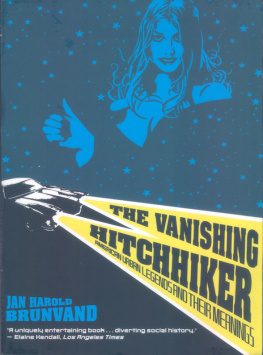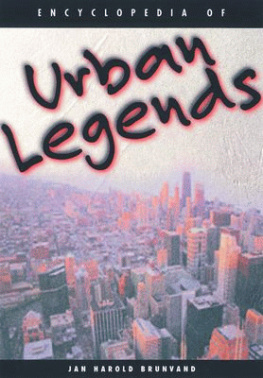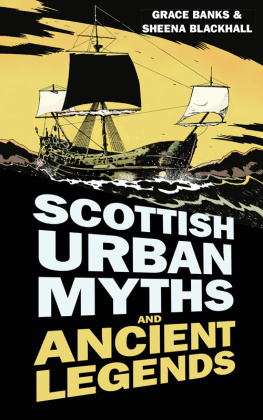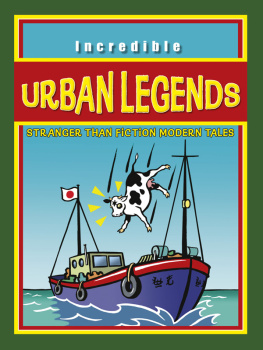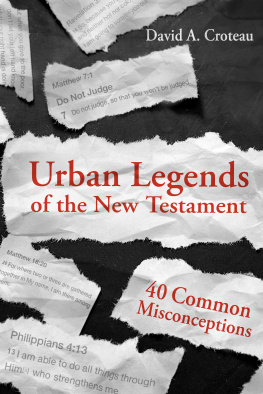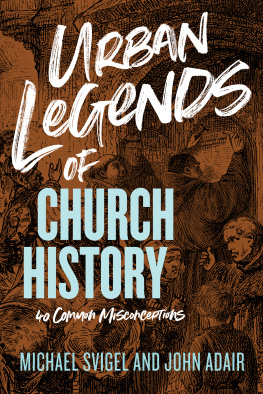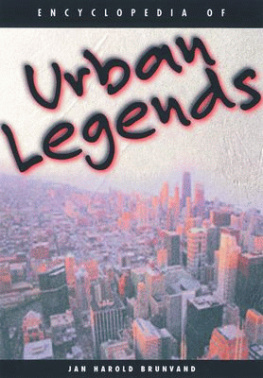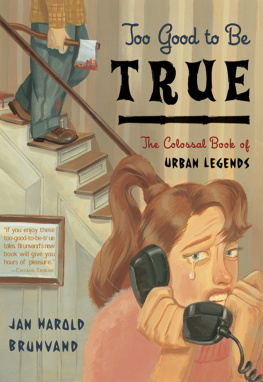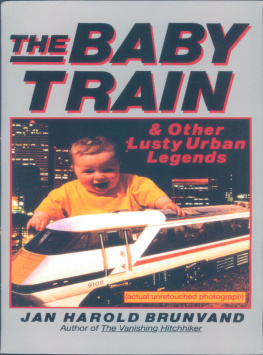THE VANISHING HITCHHIKER
Other Books by Jan Harold Brunvand
THE TRUTH NEVER STANDS
IN THE WAY OF A GOOD STORY
AMERICAN FOLKLORE: AN ENCYCLOPEDIA
THE BABY TRAIN
CURSES! BROILED AGAIN!
THE MEXICAN PET
THE CHOKING DOBERMAN AND
OTHER NEW URBAN LEGENDS
THE STUDY OF AMERICAN FOLKLORE
READINGS IN AMERICAN FOLKLORE
TOO GOOD TO BE TRUE
ENCYCLOPEDIA OF URBAN LEGENDS
The Vanishing Hitchhiker
American Urban Legends and Their Meanings
JAN HAROLD BRUNVAND
UNIVERSITY OF UTAH
W W NORTON & COMPANY
New York London
To my students
past and present
believers and skeptics alike
Contents
This is a book about modern American folk narratives, stories that most people have heard as true accounts of real-life experiences, and few except scholars recognize as an authentic and characteristic part of our contemporary folklore. Folkloristsspecialists in the collection and analysis of such traditions-refer to these believable stories about vanishing hitchhikers, batter-fried rats, grandmothers runaway corpses and the like as urban belief tales or, simply, urban legends.
The juxtaposition of the terms modern, contemporary, and urban and the word folklore may seem contradictory to those who think of folklore as charming, obsolete, unsophisticated traditions passed along by wheezing old gaffers and cackling crones in the backwoods villages of bygone days. Urban legends, on the contrary, are realistic stories concerning recent events (or alleged events) with an ironic or supernatural twist. They are an integral part of white Anglo-American culture and are told and believed by some of the most sophisticated folk of modern societyyoung people, urbanites, and the well educated. The storytellers assume that the true facts of each case lie just one or two informants back down the line with a reliable witness, or in a news media report. The mass media themselves participate in the dissemination and apparent validation of urban legends, just as they sometimes do with rumor and gossip, adding to their plausibility. But, as this book demonstrates, urban legends are folklore, not history.
In common with age-old folk legends about lost mines, buried treasure, omens, ghosts, and Robin Hood-like outlaw heroes, urban legends are told seriously, circulate largely by word of mouth, are generally anonymous, and vary constantly in particular details from one telling to another, while always preserving a central core of traditional elements or motifs. To some degreeagain like much other folkloreurban legends must be considered false, at least in the sense that the same rather bizarre events could not actually have happened in so many localities to so many aunts, cousins, neighbors, in-laws, and classmates of the hundreds and thousands of individual tellers of the tales. Both the narrative structure of these legends and their characteristic traditional folk motifs and oral variations disqualify them as literal accounts of actual events. The Hook Mans lane is a real locale in numerous communities, and a solid cement Cadillac has been reported reliably more than onceeven photographedbut the myriad re-tellings and re-localizations (sometimes internationally) of these stories reveal beyond a doubt that they are simply additional instances of our living folklore. Still, like traditional folklore, the stories do tell one kind of truth. They are a unique, unselfconscious reflection of major concerns of individuals in the societies in which the legends circulate.
It is not the purpose of folklore study to debunk oral traditions, although it may seem so to those who may have asked a folklorist about The Death Car or Red Velvet Cake only to learn that another favorite story has supposedly happened many times before to scores of other people. For a folklorist, collecting a storys variations and tracing its dissemination and change through time and space are only the beginning of an analysis. We may or may not discover an original mouse tail in a pop bottle or a spider in a hairdo, but the wide distribution and acceptance of these and other similar traditions teach us something about how Americans react to situations involving corporate or individual negligence of health and cleanliness standards. Why these stories are told is our major concern. The lessons in the mouse tail or spider legend could just as well have been promoted by means of a factory inspectors directive, but the interesting fact is that the attitudes are much more graphically and memorably conveyed among the folk by these strange, believable, false-true tales.
American folklorists have collected and published a considerable number of urban legend texts and produced a few notable studies of their variation and distribution. A great many more texts of urban legends are filed in folklore archives or are simply in individual folklorists notes. Interpretations of these traditional cultural materials are still rather scarce, however. This book brings together scholars findings on some of the best known American urban legends, along with further materials from my own files and my students papers, and suggests the larger patterns and possible meanings of these contemporary folk narratives. Of course there are possible reflections of much older motifs in some of the new legends, and finding these to analyze their psychological significance would be most interesting, but such speculation is beyond the scope of this book.
Since many of my examples come from Indiana, where numerous urban legends have been collected and studied in the Indiana University folklore program, and from Utah, where I teach, the distribution patterns indicated here are somewhat skewed. But the legends are truly national, often international, and the number of examples and variety of details could easily be expanded at least tenfold by the addition of the legend texts stored in other folklore archives and private collections. My purpose is to be broadly representative rather than definitive, since a complete study of any single urban legend could easily take a book of its own. Several of these legends are the subjects of ongoing professional studies, and wherever possible I have referred to conference papers and other unpublished material kindly made available to me by other scholars. Many urban legends have inspired popular printed, filmed, or televised plots, but a thorough and systematic review of this aspect is beyond the scope of this study. (A few such offshoots are mentioned in the notes.)
In addition to the articles and books cited in the notes and my own students work, identified wherever quoted, a number of individuals supplied me with extra information or helped to locate obscure sources. These debts are acknowledged individually in the notes, but I wish to express my deep and sincere thanks again to the following people: Louie Attebery, Ron Baker, Mac Barrick, Betty Jane Belanus, Frances Borden and Lola Preiss (of the Waldorf-Astoria), Dick Bothwell (of the St. Petersburg Times), Meg Brady, Tom Burnam, George Carey, Bill Clements, Bob Cochran, Loren Coleman, Keith Cunningham, Gary Alan Fine, Lydia Fish, Peter Goss, Sylvia Ann Grider, Sandy Ives, Bill McNeil, Donna Lou Morgan (of the Salt Lake Tribune), Lynn Packer (of KSL-TV), Sharon Pratt, Sue Samuelson, Cynthia Scheer, Mike and Dew Shonsey, Dave Stanley, Bob Steensma, and Bert Wilson.
An extract from this book appeared under the title Urban Legends: Folklore for Today in Psychology Today, J4:1 (June 1980), 5062.
We are not aware of our own folklore any more than we are of the grammatical rules of our language. When we follow the ancient practice of informally transmitting lorewisdom, knowledge, or accepted modes of behaviorby word of mouth and customary example from person to person, we do not concentrate on the form or content of our folklore; instead, we simply listen to information that others tell us and then pass it onmore or less accuratelyto other listeners. In this stream of unselfconscious oral tradition the information that acquires a clear story line is called
Next page
